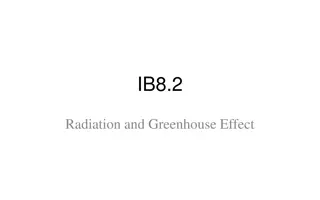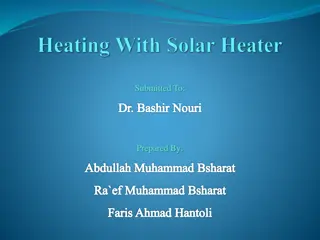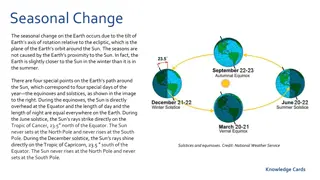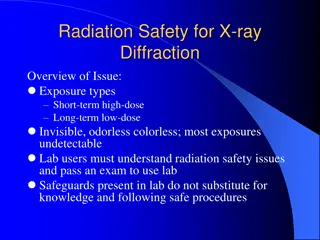Exploring Solar Radiation and its Geometric Relationship with Earth
Our planet faces challenges in energy supply, with solar radiation offering a vital alternative. Despite its intermittent nature, understanding solar energy's geometric relationship with Earth is crucial for engineering solar technologies. This chapter delves into the significance of solar information acquisition, the Earth-Sun distance, and the influence of the Sun's position on energy reception.
Download Presentation

Please find below an Image/Link to download the presentation.
The content on the website is provided AS IS for your information and personal use only. It may not be sold, licensed, or shared on other websites without obtaining consent from the author. Download presentation by click this link. If you encounter any issues during the download, it is possible that the publisher has removed the file from their server.
E N D
Presentation Transcript
Chapter Two Solar Radiation
Introduction Our planet faces significant challenges in the twenty- first century because expected to double globally during the first half of this century. Faced with increasingly constrained oil supplies, humanity must look to other sources of energy, such as solar, to help us meet the growing energy demand. Solar radiation is the most important natural energy resource because it processes acting at the surface of the Earth. The Sun provides the Earth with an enormous amount of energy. The energy stored by the oceans helps maintain the temperature equilibrium level that allows for stability for a broad diversity of life. energy consumption is drives all environmental of the Earth at an
Although the solar energy source is inexhaustible and free, it is not the most convenient energy source due to its intermittent nature. In contrast, modern lifestyles demand a continuous and reliable supply of energy. However, there are ways to overcome these shortfalls. In order to understand solar energy, this chapter discusses the resources, including energy irradiated from the Sun, the geometrical relationship between the Sun and the Earth, and orientation of energy receivers, as well as the importance of acquiring reliable solar information for engineering design, operation, and management of solar technologies.
SunEarth Geometric Relationship The amount and intensity of solar radiation reaching the Earth s surface depends relationship of the Earth with respect to the Sun. on the geometric The position of the Sun, at any moment at any place on Earth, can be estimated by two calculations: 1. simple where the inputs are the day of the year, time, latitude, longitude, 2. calculations through complex algorithms valid for a limited period varying from 15 to 100 years; types of equations and Figure Earth Sun geometric relationships
EarthSun Distance The Earth has a diameter of 12.7 103 km, which is approximately 110 times less than the Sun s. The Earth orbits approximately once around the Sun every 365 days. The elliptical path of the Earth varies from 14.7 107 km in early January the closest distance to the Sun, called perihelion to 15.2 107 km in early July the farthest distance, called aphelion. The average Earth Sun distance of 14.9 107 km is defined as the astronomical unit (AU), which is used for calculating distances within the solar system. The Earth Sun distance (E0) in astronomical units is n is the day of the year (1 n 365)
Table : Declination and EarthSun Distance of the Representative Averaged Days for Months Apparent Path of the Sun The Earth rotates at an approximately constant rate on its axis once in about 24 hours. Such rotation in the eastward direction gives the sense that the Sun moves in the opposite direction.The so-called ecliptic is the apparent path that the Sun traces out in the sky while it goes from east to west during the day.
The rotation axis of the Earth is tilted 23.45 from being perpendicular to the ecliptic plane and as a result, the angle between the Sun and a point on the surface of the Earth varies throughout the year and, with this, the length of day also changes. Day length is determined by the length of time when the Sun is above the horizon and varies throughout the year as the Earth Sun geometric relationships change. Again, the Earth s tilt has a great effect on what an observer sees, depending on whether he or she is in the Northern or Southern Hemisphere, as shown in Figure below. Figure Apparent daily path of the Sun in the sky throughout the year for an observer in the Northern (left) and Southern Hemispheres (right).
Earth and Celestial Coordinate Systems Any location on Earth is described by two angles, latitude ( ) and longitude ( ). The latitude corresponds to the elevation angle hypothetical line from the center of Earth to any point on the surface and its projection on the equator plane (fall between 90 < < 90 ) The longitudes are imaginary lines extended from pole to pole and are called meridians; For each meridian crossing the equator s circle, there is an angle assigned. between a Longitudes are measured from 0 to 180 east of the Prime Meridian and 180 west. Figure Earth coordinate system.
Declination Angle ( ): If a line is drawn between the center of the earth and the sun, the angle between this line and the earth s equatorial plane is called the Declination angle ( ), Similarly to the latitude concept on Earth, the declination celestial sphere measured northward or southward celestial equator plane on the is from the Figure Celestial coordinate system.
Declination Angle () of the sun varies daily and is calculated from the following relation: where n is the day of the year. Position of the Sun with Respect to a Horizontal Surface In addition to the fixed celestial coordinate systems on the sky, to describe the Sun s position with respect to a horizontal surface on Earth at any time, the following angles are important i. Solar altitude anlge ( s), ii. Zenith angle ( z), iii. Solar azimuth angle ( s), and iv. Hour angle ( )
Solar altitude anlge (s): it is measured in degrees from the horizon of the projection of the radiation beam to the position of the Sun. When the Sun is over the horizon, s= 0 and when it is directly overhead, s= 90 . Fig. Position of the Sun in the sky relative to the solar angles.
Zenith angle (z) : it is the angle of the Sun relative to a line perpendicular to the Earth s surface. and the zenith angle is given by Solar azimuth angle ( s),it is the angle on the horizontal plane between the projection of the beam radiation and the north south direction line. Positive values of sindicate the Sun is west of south and negative values indicate when the Sun is east of south for northern hemisphere and vice-versa for the southern hemisphere.
Hour angle () it is the angular distance between the Sun s position at a particular time and its highest position for that day when crossing the local meridian at the solar noon. Because the Earth rotates approximately once every 24 hours, the hour angle changes by 15 per hour and moves through 360 over the course of the day. The hour angle is defined to be zero at solar noon, a negative value before crossing the meridian (morning), and a positive after crossing (afternoon). Hour angle and solar time ST in hours are related as: Example Calculate the zenith and solar altitude angles for Addis Ababa at (a) 10:30 a.m. and (b) 3:15 p.m. solar time on April 17.
When the solar incident radiation on a horizontal- solar collector is calculated, two new angles should be defined. The slope-surface angle ( ) indicates how inclined the collector is from the horizontal; on a horizontal collector, = 0 . The allowed range for goes from 0 to 180 . The other relevant corresponds to the surface-azimuth angle ( ), which indicates how far the solar collector deviates from the north south axis. This angle is measured between the horizontal projection of the surface normal and the north south direction line, with 0 due south and negative values to the east of such an axis; 180 180 . angle for calculations
Position of the Sun with Respect to a Tilted Surface The maximum solar energy collection is achieved when the Sun s rays are perpendicular to the collecting area (i.e., parallel to the surface normal). This can be achieved only when solar tracking systems are used to modify the slope or the surface azimuth or both angles during the collector s operation. The fixed- collectors are the most practical receivers and the most widely installed throughout the world. In order that the fixed- collectors capture most of the annual incoming solar radiation, the surfaces must always be tilted facing the equator. Several criteria might be used to select , such as maximum collection for the greatest energy demand period or optimization during the whole year.
Solar incidence angle (). It is the angle between the solar radiation beam incident on a surface and the imaginary line normal to such a surface. At = 0 , the Sun s rays are perpendicular to the surface and, when = 90 , the Sun s rays are parallel to the surface. Maximum solar gain for any solar intensity is achieved when the incidence angle is zero because the cross section of light is not spread out and also because surfaces reflect more light when the light rays are not perpendicular to the surface. The angle of incidence can be calculated by any of the following equations: OR
The sunset hour angle (sunset) can be derived when z = 90: Because 1 hour equals 15 of the Sun traveling through the sky, the number of daylight hours (N) can be determined by solving the above equation for sunset and converting the resultant degrees into hours:
1.1.2 Solar Spectrum Extraterrestrial radiation - the radiation that would be received in the absence of the atmosphere. As shown in Fig. 1.2, the maximum spectral intensity occurs at about a wavelength = 0.48 m in the green portion of the visible spectrum. About 6.4 % of the total energy is contained in ultraviolet region ( < 0.38 m); Another 48 % is contained in the visible region (0.38 m < < O. 78 m); and The remaining 45.6 % is contained in the infrared region ( > O. 78 m).
The solar irradiance from the black body, either sun or earth, as a function of wavelength ( m) can be governed by Planck's law of radiation given by: (1.2) where: Eb the spectral emissive power -represents the energy emitted per unit area per unit time per unit wavelength ( m) interval at a given wavelength; C1= 3.742 x 108W. m4/m2 (3.7405 x 10-16m2W); C2= 14387.9 m K (0.0143879 m K). The variation of the solar irradiance Eb with wavelength in m is shown in Fig. 1.3.
The total emitted radiation from zero to any wavelength from the sun can be obtained from Equation 1.2 as: (1.3) Frequently one needs to know the amount of energy emitted by a black body within a specified range of wavelengths. This type of calculation can be performed easily with the aid of the radiation functions. To construct the appropriate radiation functions in dimensionless form, the black body radiation can be made a function of only the single variable T. The value of f0- T for different T in m K are given in the Table 1.2.
Example Calculate the fraction of the extraterrestrial solar radiation and the amount of that radiation, using values in Table 1.2 or 1.3 and T = 5777 K, if the total emitted radiation is 1367 W/m2: a) The ultra violet region (0< <0.38 m), b) The visible region (0.38< <0.78 m), and c) The infrared region ( >0.78 m),
1.2 Variation of Extraterrestrial radiation Solar radiation outside of the earth's atmosphere is called extraterrestrial solar radiation. The intensity of the extraterrestrial radiation outside a planet varies inversely to the square of the distance of the planet from the sun. If the intensity of the radiation at a point and the distance of the point from the sun is known, then the intensity at another point can be calculated from the knowledge of its distance from the sun.
The earth revolves around the sun every 365.25 days in an elliptical orbit called the ecliptic plane, with a mean earth-sun distance of 1.495 x 1011 m defined as an astronomical unit (1 AU = 149.5 million km). The earth's orbit reaches a maximum distance from the sun, or Aphelion, of 1.52 1011 m on about the 3rd day of July. The minimum earth-sun distance, the Perihelion, occurs on about January 2nd, when the earth is 1.47 1011 m from the sun. The distance between the sun and the earth varies every day and is a minimum on January 2 and a maximum on July 3.
Solar irradiance varies by 3.4% with the maximum irradiance occurring at the Perihelion (where the earth is closest to the sun) and the minimum at the Aphelion (where the earth is farthest from the sun). Solar Constant (Isc) The solar constant (Isc) is the total amount of electromagnetic energy that falls on a unit area normal to the sun in unit time at the top of the earth s atmosphere when the earth is at its mean distance from the sun. The current accepted value of Isc is 1367 W/m2. The top of the atmosphere is about 40 km from the earth's surface.
A study of the extraterrestrial radiation is important because of the following features: It indicates the maximum possible radiation that could be expected on the earth's surface (on an extremely clear day). The extraterrestrial radiation on top of the earth s atmosphere could be used as a reference in the absence of solar radiation data on the earth s surface. Expressions related to the extraterrestrial radiation can be applied to generate solar radiation data on the earth s surface. A knowledge of the spectral distribution and the radiation intensity identifies in what wavelength energy is greater.
1.2.1 Intensity of Extraterrestrial Radiation The extraterrestrial radiation (ETR) falling on a surface normal to the sun's rays at 1 AU (mean sun earth distance) is given by solar constant (Isc). The intensity of extraterrestrial radiation Iext measured on a plane normal to a surface on the Nth day of the year is given in terms of solar constant (Isc) as follows (Duffie and Beckman, 1991): (1.4)
An important concept that is often used in solar irradiance models is the extraterrestrial solar irradiance falling on a horizontal surface. Consider a flat surface just outside the earth s atmosphere and parallel to the earth s surface below, Fig. 1.5. When this surface faces the sun (normal to a central ray), the solar irradiance falling on it will be Io , the maximum possible solar irradiance. If the surface is not normal to the sun, the solar irradiance falling on it will be reduced by the cosine of the angle between the surface normal and a central ray from the sun.
Fig 1. 5 The cosine effect as related to the concept of extraterrestrial horizontal irradiance
The rate of solar energy falling on both surfaces A and B is the same. However, the area of surface A is greater than its projection (hypothetical surface B), making the rate of solar energy per unit area (i.e. the solar irradiance), falling on surface A less than on surface B. The extraterrestrial solar irradiance falling on a surface parallel to the ground is: (1.5) where: Io is the extraterrestrial solar irradiance, and z is the angle between the two surfaces.
Reduction of radiation by the cosine of the angle between the solar radiation and a surface normal is called the cosine effect. The cosine effect is an extremely important concept in optimizing the orientation of solar collectors. The variation of extraterrestrial radiation with Nth day of the year is shown in Fig. 1.6. For December 21, 1995, N = 355, Iext= 1411 W/m2. For June 22, 1996 (Leap Year), N = 174, Iext = 1322W/m2.
Fig 1. 6 Variation of extraterrestrial solar radiation with time of the year
1.2.2 Terrestrial and Extraterrestrial Regions Fig. 1.7 shows the position of terrestrial and extraterrestrial regions. X-rays and extreme ultra-violet radiations of the sun are highly absorbed in the ionosphere by nitrogen, oxygen and other atmospheric gases; Ozone and water vapors largely absorb ultraviolet ( < 0.40 m) and infrared radiations ( > 2.3 m), respectively. There is almost complete absorption of short wave radiations ( < 0.29 m) in the atmosphere. Hence, the energy in wavelength radiation < 0.29 m and > 2.3 m of the spectra of the solar radiation, incident on the earth's surface is negligible.
Fig 1. 7 Positions of Terrestrial and Extraterrestrial Regions
Air Mass Air mass is the ratio of the distance that solar radiation travels through the earth s atmosphere (path length), to the distance (path length) it would travel if the sun were directly overhead. Radiation coming from therefore, is said to pass through an air mass of 1.0 at sea level. Solar irradiance coming from a zenith angle of 60 degrees, would pass through approximately twice the perpendicular path length and hence an air mass of 2.0. Large value of air mass indicates that solar radiation travel greater distance in atmosphere. directly overhead,
An expression for air mass (referring to Fig. 1.8) is: (1.6) Fig 1. 8 Directions of sun s ray with respect to atmosphere
The following expression has been developed by Kasten and Young (1989) to approximate air mass at any zenith angle: (1.7) where: the zenith angle z is given in degrees. At sunset ( z = 90 ), Eq. (1.7) gives a value of 37.92 and that is why there is very little solar radiation reaching the earth s surface at sunset. For altitudes other than sea level, the air mass calculated above is reduced by the ratio of the local atmospheric pressure to standard sea-level atmospheric pressure.
Classification of Solar Radiation The solar radiation passing through the atmosphere and reaching the earth's surface is classified into two components: Beam radiation and Diffuse radiation. Beam radiation Ib: is the solar radiation propagating along the line joining the receiving surface and the sun. It is also referred to as Direct radiation. Diffuse radiation Id: is the solar radiation scattered by aerosols, dust and molecules. It does not have a unique direction. The total radiation I (or IT) is the sum of the beam and diffuse radiation and is sometimes referred to as the Global radiation.
Some of the terms used in solar energy applications are: Irradiance (W/m2): The rate at which radiant energy is incident on a surface per unit area of surface. Irradiation or radiant exposure (J/m2): The incident energy per unit area on a surface, found by the integration of irradiance over a specified time, usually an hour or a day. Insolation is a term applied specifically to solar energy irradiation. The symbol H is used for insolation for a day and I for insolation for an hour. Both H and I can represent beam, diffuse or total and can be on surfaces of any orientation.
Solar Time (ST) Clock time is described based on longitudes and is dependent on the standard meridian for each country (region). The earth makes a complete rotation on its axis once in 24 hours, thereby moving across 360 longitude. The sun, therefore, takes 4 minutes to traverse 1O of longitude or 15 per hour. Solar Time (ST) is based on the 24-hour clock, which is defined as the time interval between two successive passages of the sun across the meridian of the observer.
The concept of solar time is used in predicting the direction of sunrays relative to a point on the earth. Solar time is the time used in all sun-earth angle relationships; it does not coincide with local clock time. There is a constant correction for the difference in longitude between the (longitude) and the meridian on which the local standard clock time is based. observer s meridian
The difference in minutes between solar time and standard clock time is: (1.8) where: Lst = the standard meridian for the local time zone, Lloc= the longitude of the location in question (in degrees west), and EOT = the equation of time (in minutes) given by: (1.9) Where : N = day of the year
The level of accuracy of the determination of EOT depends on whether the data is required for system performance analysis or developing tracking equations. An approximation for calculating the EOT [min] as stated by Woolf, with accuracy of about 20 min is : (1.10) where: the angle B is defined as a function of the day number N and given by:
Another expression for the determination of the EOT [min], derived by Spencer (1971) and cited by Iqbal (1983) is given in Equation (1.11): In this expression all angles are described in degrees and not radians. (1.11) where: N = Day of the year, with N = 1 for January 1.
An approximation for calculating the EOT [min], with an absolute error of 2 second has also been presented by Lamm (1981) as given in Equation (1.12). The resulting value of the EOT is positive when the apparent solar time is ahead of mean solar time and negative when the apparent solar time is behind the mean solar time. (1.12) The coefficients Ak and Bk are given in Table 1.3























